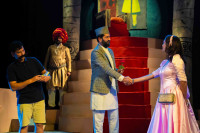Culture & Lifestyle
‘Chiso Ashtray’ does everything except tell a satisfactory story
The film is artistic with its stunning visuals and dazzling costume designs but it’s missing the basic elements of storytelling.
Shranup Tandukar
Among the 42 poems in ‘Ghumne Mech Mathi Andho Manche’, a poem collection by Bhupi Sherchan, one particular poem stands out as an unflinching scrutiny of Kathmandu city. Comparing the city to a cold ashtray, the poem ‘Chiso Ashtray’ laments that Kathmandu turns hopeful new immigrants into broken people with crushed dreams.
‘Chiso Ashtray’ film, named after the eponymous poem by Bhupi Sherchan, raised high expectations when its trailer was released three weeks ago. The trailer has stunning visuals accompanied with upbeat background music, but it was all over the place—lacking an emphasis on the actual underlying story. The trailer looked like it was confused about its own identity and that was a harbinger of the major flaw in the recently released film.
There’s a sequence in Chiso Ashtray where the ‘good guys’ consisting of the lead character Madan(played by Divya Dev) and his two friends, Rooney(played by Nikun Shrestha) and Jacky(played by Nabin Lamsal), play a game of pool against the ‘bad guys’ consisting of the ring leader Bikki and his two sidekicks, Bhukka and Mukka. There’s a decent chunk of money at stake, an arbitrarily agreed upon amount of Rs 20,000 between Jacky and Bikki. The whole sequence gets drawn out—the camera pans round the characters, Jacky and Bikki keep scoring, and the camera keeps on showing glimpses of other character’s anxious faces. The tension in the scene keeps building up but it all culminates into nothing. Jacky gets provoked and becomes aggressive so Bikki, after teasing Jacky and having his fun, walks away from the game without any repercussions. The whole buildup in the scene, the rise in tension, and the expectation of a confrontation fizzles out into nothing. It feels like there was no point to the whole sequence. Much like the entire film.
Madan is a young man who arrives at Kalanki from his village with fire in his eyes. His backstory and history remains an enigma throughout the film as he never discloses anything about himself prior to his arrival at Kathmandu. When he is asked about the name of the village, he replies “gau ko ni kaha naam huncha ra? Only cities have names.” (Villages don’t have names, do they? Only cities have names.)
One fateful night, Madan rescues Bobby dai, played by Robin Tamang, who gets into a car accident. In return, Bobby dai gives a Toyota car to Madan which he then uses as a taxi to earn some side money. While he calls himself a taxi driver, Madan only picks up passengers when he is in a mood to do so but seemingly never runs out of money. Madan gawks at fancy stores at Durbar Marg with envy; he wants to change himself to become ‘modern’. He becomes infatuated with Salinta, played by Shristi Shrestha, a cafe owner and performance artist who goes around sticking white butterflies on electric cables, trees, and streets of Kathmandu (which was inspired by Milan Rai’s artwork with butterflies).
Madan comes across Rooney, a live music singer, when he picks him up in his taxi after Rooney’s gig at Thamel. Rooney dozes off in his drunken stupor and doesn’t give his home address to Madan so Madan brings Rooney to his own rented flat for the night. Soon after, Madan and Rooney become fast friends and Rooney coaxes Madan to try smoking weed. Rooney finds out that Madan writes poems in cigarette packets and proposes a plan to make a music video with Madan’s lyrics and Rooney’s music.
For the third person who will oversee all the production aspects of the music video, the two friends reach out to Jacky, an old-time friend of Rooney. Jacky, an avid pool player, apparently spends his time going to the gym and earning money winning bets on pool games. After the three bond together with the help of drinks, dances, and drugs in the bars of Thamel, Jacky also agrees to join the music video production. The three friends agree to invest one lakh each but that won’t be enough to create a ‘Hollywood-style’ music video so Jacky proposes to try their luck at a casino. And without much effort, they win big at the casino and now have a duffel bag full of notes.
While the plot moves along, the rival gang of Bikki (played by Sushil Raj Pandey) appears often in scenes ominously looking at the three friends from afar. While the makers may have thought that showing Bikki keeping a close eye on Madan will build suspense, all it does is reduce Bikki’s character to a hackneyed scarecrow.
The second half of the film that deals the climax is also pitiful; the shooting of the music video gets derailed, friendships shatter and splinter, and Madan realises the cost of trying to be ‘modern’. The filmmakers describe the film as a “postmodern drama about an innocent village guy freshly arrived in the capital city.” But while the first half of the film deals with Madan trying to find his place in the glitz and glamour of Kathmandu, the second half simply becomes a clichéd love story where the male lead character finds out that one of his close friends has harassed Salinta and he must now redeem himself in the eyes of his love interest.
The flaw with the whole film is simple: we do not feel for the lead character Madan at any point in the film. Not when he is getting beat up by the thugs, not when he narrates seemingly profound poetry lines, and certainly not when he transforms himself from ‘modern’ to ‘simple’ for his love interest. Madan’s history and his aspirations remain an enigma throughout the film. He never struggles to become a part of the bustling Kathmandu; he has a steady source of income, and he has a posh rented place. He walks, talks, acts, appears, and lives as a Kathmandu native from the beginning so how can we ever empathise with his sentiments of being an outsider? A few flashbacks to his early days arriving in Kathmandu with simple clothes simply don’t warrant an outsider label.
Only Rooney has a semblance of a character arc. As a singer who only ever performs in live gigs in Thamel, he dreams of making his own music video soon. That will be his ticket to the limelight. He is not a saint by any means; he is the one who peer pressures Madan into using soft and hard drugs. But still, he has a purpose and when his dreams shatter, we do feel bad for him.
Watching ‘Chiso Ashtray’ is a bittersweet experience. The first time you watch it, you become frustrated with the pointlessness of the film and the lack of any real story. The second time you watch it, you can sort of understand what the makers were trying to do with the film. The cinematography by Ujjal Baskota is topnotch; the acting of everyone except Shristi Shrestha is decent and natural; Sujan Pariyar, the costume designer, successfully layers meanings with the costume changes; Uttam Neupane, the sound designer, uses sound elements with innovation; but the effort of all the crew comes to naught when director, writer, and one of the editors, Dins Palpali fails to string together a purposeful story with a relatable character.
Critics have pointed out time and again how Nepali films’ major weakness is their scripts and ‘Chiso Ashtray’ rises up as yet another case study to that reasoning. Imagine: you hire a contractor to build a small one-storied house. The contractor imports branded raw materials from abroad, hires the best local artisans and designers, spends years on the project, and turns the interior into a work of art. However, they fail to put up a roof and a ceiling for the house. That’s exactly what watching the film feels like. It’s a work of art but it’s simply not a film worth spending your hard-earned money to watch in a theatre hall.




 13.12°C Kathmandu
13.12°C Kathmandu


.jpg&w=200&height=120)












